Fred Martin
A Retrospective, 1948-2003
Catalog illustrations with commentaries...
Catalog nos.
119-137
Click for
Catalog
nos. 1-26.
Catalog
nos. 30-54
Catalog
nos. 55-63
Catalog
nos. 65-77
Catalog
nos. 78-115
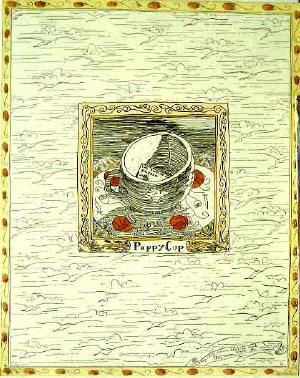 |
Cat. no. 119 The Poppy Cup. 1966.
A Proof
from Beulah Land.
San Francisco: Crown Point Press, 1966.
A
book of 15 etchings, some with hand coloring, 18 x 12 in.
Collection Oakland Museum.
In
1965-6, I condensed/confirmed the imagery of the 18 x 18 inch collages
into a series of etchings of Beulah Land, the place in Paul Bunyan’s
Pilgrim’s Progress where the good go just outside the gates of
Paradise to wait for final entry to Heaven. My book showed the way
there, the objects and landmarks and emblems of the place, and the
entrance to Arcadia (from Poussin’s Et in Arcadia Ego) at the
end. This is a hand-colored proof of a plate for the upper part of a
page in
Beulah
Land.
Throughout the book, I used nineteenth century ideas and images of
California like the crockery I imagined my great aunts had that was
decorated with California poppies and blue birds of happiness. I made
the Poppy Cup a symbol of woman as well as the pot of gold at
the end of the rainbow. It was nineteenth century California as the
golden land of plenty.
|
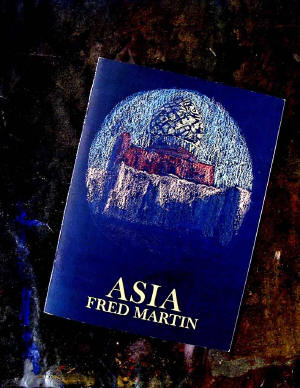
|
Cat. no. 121. Asia, the catalog
for my
show of travel pastels at SFAI in 1972.
16 pp, 7½ x 5½ in.
By
the late fall of 1971, I had figured out how to use the slides from
around the world, from Rome to Rangoon. I made a dark ground of
acrylic modeling paste mixed to a creamy consistency, projected the
slides onto it and traced the basic outlines in gold pencil. Then, I
used soft pastels for the color. Soft pastels on a dark acrylic
ground on watercolor paper makes the same luminous color effect as oil
painting on velvet. Yes, maybe it’s vulgar, but it could handle all
my romance of Asia—and Crete and Greece and a year or two later
Egypt.
Asia
(the
catalog above), was the result.
|
 |
Cat. no. 122. Cover
design for A Travel Book. 1976.
20¼ x 30 and 3/8 in.
In
spring 1975, Andrew Hoyem proposed we make a book together at his
Arion Press. I took my journal from the around-the-world Asia trip of
1971, transformed it with reading in Avicenna and Henri Corbin about
ancient Iranian religion, and made A Travel Book. I made the
plates by 1) painting a watercolor and tracing a line drawing from it;
2) making a line cut from the drawing and printing the cut on as many
linoleum blocks as there would be colors in the plate; and 3) cutting
the blocks for each color in printing order. I worked at the press
and while each block was being printed, I cut the block for the next.
I drew and we printed this silkscreen for the cover before the book
was bound. A Travel Book crosses Asia from West to East, from
Avicenna’s Occident of mud and ruin to the Orient I found in the
mandala that is the base of the Shwe Dagon in Rangoon.
|
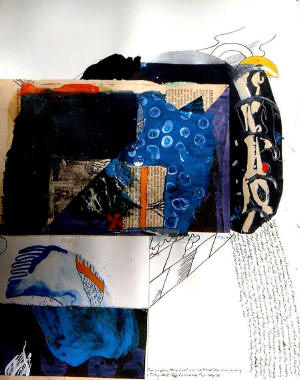 |
Cat. no. 131. “They gave me an instrument of
brass…” 1979.
Watercolor collage on paper, 14 x 11 in.
While
I was working on the large and then half-size watercolors from my
“astral travels,” the idea came to make a book from my journal. I
wanted the book to be as stark and cheap as A Travel Book had
been lush and expensive. Ultimately, I published From an Antique
Land with “Green Gates Press”—our house on Monte Vista. I had
read that you should be able to make a good idea into a short story, a
novel or a play or all three. I took the text of From an Antique
Land, made collages as parallel works of art, and made slides from
the collages to use with readings from the book. In this way from one
idea I had a book, a suite of collages and a public reading. When I
gave the reading to my students at SFAI, the only question was, “Did
that really happen?” My only answer was, “Yes.” “They gave me an
instrument of brass…” is one of the collages.
|
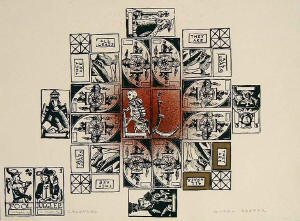 |
Cat. no. 135.
Wheel Reaper. January 4, 1980.
Block print with
watercolor, 22 x 30
It
was a great idea (I guess) to make my “astral travel” notes into a
book, a suite, and a reading, but by the time I had done that I had
like always used up everything. Even the imagery that had come to me
in the late 1950’s to early 1960’s and I had used for nearly twenty
years, I had worn down to nothing. I was teaching at San Jose State,
and a student showed me some things she had made based on Tarot
cards. I remembered our old set and decided to explore not my
personal imagery but an archetypal system that had been built
anonymously over centuries—Jung’s “objective unconscious.” I began
with drawings of each of the major arcana, then made one by one a
linoleum block of each, printing each block as I went along first in
every combination with itself that I could think of, then printing
each in combination with all the others that had so far been cut.
|
 |
Cat. no. 136.
Narcissus, Narcissus, Tell Me What You See. January 7, 1981.
Block print with watercolor, 22 x 30 in.
I
went through the whole major arcana, from card to card building image
after image. I even tried fortune telling. I had been promised an
important job, but the people who made the promise did not confirm.
Not sure what to do, I set my Tarot blocks to find out. The resultant
image was a mess of fear. I wondered if I should use my images in
this way, and tried the “Yes/No” spread to find out. I got six NO
in a row. It had been over a year and half with the Tarot and my
blocks when I made this early January 1981 image in which I gaze into
the pool of my future. Soon after, I stopped using my blocks and the
Tarot images. I had worn them out and I went back to the big
watercolors. Maybe they were not as majestic as the big acrylics of
the 1960s, but they were certainly bigger and more powerful than my
then worn out soul.
|
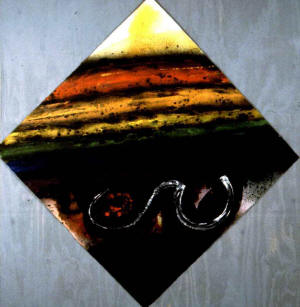 |
Cat. no. 137. K in
Diamond. 1994.
Acrylic on paper, 63 x 63 in.
When I was a sophomore
at Berkeley in 1947, the Guggenheim Museum’s publication of
Kandinsky’s On the Spiritual in Art was one of my most
important books. In the early rush of eros and sensuality and
imagination and aspiration that ran through me after my marriage to
Stephanie Dudek, I made this painting to recapture that 1947 time and
feeling of apocalypse and heroism. It shows the rainbow of the colors
of the beauty and glory of the world (I guess Kandinsky would have
appreciated that), and the painting shows my male seed squirming and
fertilizing like an infinity sign in the earth below. The painting
tells how I was reborn, and the rainbow of the spirit proves it. Yes,
the necklace in eternity is broken, but I have found its jewels
everywhere. And the mountains of infinity? Their shining peaks are
calling.
|
|
|
|
Click for
Catalog
nos. 1-26.
Catalog
nos. 30-54
Catalog
nos. 55-63
Catalog
nos. 65-77
Catalog
nos. 78-115
Catalog
nos. 119-137
|